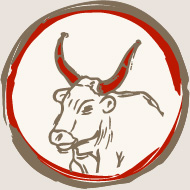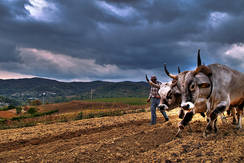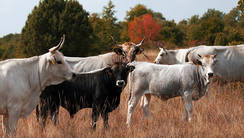Permanent preservation of istrian cattle
Istrian cattle
Istrian cattle belongs to the line of original ancestral cattle, closely related to the aboriginal fossil species bos primigenius. Fossil findings indicate that the bos primigenius, as the dominant species on the Istrian peninsula, lived on lowland pastures and in open forests, surviving winters by feeding on shoots and gems and burning reserves of fat stockpiled when food was more abundant.
Fossil findings from various sites around Istria testify to the presence in Istria of this ancestor of present-day Istrian cattle. Traces of cattle, mostly bos primigenius, have been found on numerous sites in Istria, most frequently in: Kanegra quarry - Sičal Cove, Hijenska špilja – Buje, Golupska jama - Buzet, Pećina Svete Ane - Trsat, Kupića pećina – Oranje, Pećina na Doleh and Šandalja II – near Pula. There is evidence showing that the Istrian cattle developed from cattle that were brought to Istria by Roman legions and Attila’s hordes descending from the steppes of southern Russia and Bessarabia.
Towards the end of the 18th century, Istrian cattle were enriched with an input from primigenial bulls of the Podolian breed from Romagna and Apulia, then from the Marche and Polesine. At the turn of the century, a similar attempt was made in one part of Istria with bulls of the Romagnola and Maremmana breeds. The fresh blood contributed to create the “Buie Cattle”, named after the place where it was bred. Ameliorative cross-breeding greatly improved meat production, leading to a better body conformation, feed conversion and more intensive yield.
The industrialisation of agriculture, the appearance of mechanisation, social trends in rural areas and the economic orientation towards tourism in the early 1950’s resulted in the replacement of Istrian cattle with more productive breeds. Crops and vineyards became the prevalent cultures, whereas cattle farming took on a secondary role.
In the 1970’s and 1980’s there was a significant reduction in the Istrian cattle population. In 1972 there were 10,500 Istrian cattle breeding cows registered on the territory of Istria; by the end of the 1980’s that number had dropped to a little over 100 cows. Putting the spotlight on the issue of Istrian cattle extinction triggered public discussions and led to the first measures to preserve and revitalise the existing population.
Physical characteristics of Istrian cattle
Istrian cattle is a late maturing breed, reaching maturity at the age of 6 to 7 years. They are long-lived, can be used for work and breeding for as long as twenty years. Fertility, manifested as a regular and long-lasting ability to sire offspring, is one of the factors affecting both production and survival of Istrian cattle.
The head of Istrian cattle is of medium length, wedge-shaped, wide at the forehead and narrowing down towards the muzzle. The forehead is of medium width, sometimes slightly indented, the nose and face are elongated.
The horns are large and lyre-shaped, up to 1.5 m long and reaching up to 30 cm of circumference at horn base, with a spread of up to 1.2 m at the top. The horn base is greyish to yellowish, and from mid-height to the top it is grey to dark. The bulls’ horns are shorter and wider, whereas the cows’ (oxen) horns are longer and narrower.
The neck is muscular, of medium length and thin. The dorsal line is straight.
The frame is well built and harmonious. Muscles are rather well developed but still need some improvement in further breeding. With its well developed frame and strength, Istrian cattle as working animals met the needs of Istrian farmers, but the current focus on beef production will require an improvement in meat production and yield.
The withers height of Istrian cattle is 136 - 142 cm (fully grown cows) or145 - 150 cm (fully grown bulls). The body length of cows is 155 - 170 cm (≈ 110 – 115% of withers height). The chest is deep, long and somewhat narrower. Chest depth ranges from 51 to 53% of withers height, whereas chest width amounts to 30 or 33% of withers height. Rump length is 36 to 38% of withers height, whereas rump width is 33 to 34% of withers height. The rump is long, narrowing and descending towards the end.
The legs are strong, well built, the stance is good. The rear leg is strong. The cannon bone circumference is 18 to 20 cm. The hooves are hard, solid bone, rimmed with black hair.
The body mass of Istrian cattle cows is 500 to 600 kg, of bulls it is 650 to 900 kg. Oxen reach a body mass of 1100 to 1300 kg.
The hair colour is light grey to white, with transitions to darker tones. The bulls are darker than cows. The cows are light-grey to white with some darker nuances. Claves are reddish-brown, changing to grey at the age of 3-4 months. Typical of Istrian cattle is a somewhat darker colour around the mouth, the nose ridge, parts of the face, around the eyes and ears, the tail end, the shoulders, the fetlocks, the neck and the outer ribcage. The membranes of eyelids and lashes are dark. The tongue is lead-grey and the palate is completely or mostly dark. The areas of the anal cavity and the vulva are grey to black. The bulls’ scrotum is dark from the lower third to the middle.
In terms of temperament, Istrian cattle are docile, stable, steady, obedient and undemanding. For centuries, Istrian farmers have bred Istrian cattle as intelligent and obedient animals, with moderate feed requirements, to work the Istrian soil and produce food for both. Breeding should continue along these lines.
Production characteristics of Istrian cattle
Production characteristics of Istrian cattle have been developed giving priority to work over meat and milk, in line with the requirements of the times. Istrian cattle were primarily used for work, meaning that breeders were not interested in milk yield. This has made Istrian cattle less competitive in conditions of intensive agricultural production. Although meat production was not improved systematically, there are indications that selection and a greater focus could greatly improve meat production.
Istrian cattle were renowned for their exceptional aptness for work, resilience and steadiness. They were mostly harnessed in iron-framed wooden carts and attached to them with chains (tiraduri). The animals were mostly muzzled with wicker made of golden willow to prevent them from eating vine and pasture on the way to the fields. The horntips were fitted with brass spheres to protect people and cattle from injuries during work on fields and in sheds, and on the forehead the animals had fringed rope to protect them from flies. Yokes were made of chestnut or oak.
Throughout history, Istrian cattle were not bred to produce milk. The simple living conditions and the work they were subject to did not leave much room for milk production. The milk had to be enough to feed calves and provide modest quantities for the households. Past research has shown that the milk yield of Istrian cows ranges from 800 to 1500 kg, with more than 4.2% milk fat.
Partners in the project:







